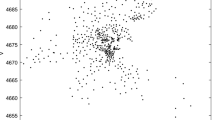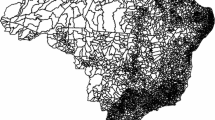Abstract
This paper focuses on the hypothesis of stability in the mechanisms of spatial dependence that are usually employed in spatial econometric models. We propose a specification strategy for which the first step is to solve a local estimation algorithm, called the Zoom estimation. The aim of this stage is to detect problems of heterogeneity in the parameters and to identify the regimes. Then we resort to a battery of formal Lagrange Multipliers to test the assumption of stability in the processes of spatial dependence. The alternative hypothesis consists of the existence of several regimes in these parameters. A small Monte Carlo serves to confirm the behaviour of this strategy in a context of finite size samples. As an illustration, we solve an application to the case of the hypothesis of convergence for the per capita income in the European regions. Our results reveal the existence of a strong Centre-Periphery dichotomy in which instability extends to all the elements (coefficients of regression as well as parameters of spatial dependence) that intervene in a classical conditional β-convergence model.





Similar content being viewed by others
Notes
Due to length restrictions, we have not included the results for the \( \mathop {\text{LM}}\nolimits_{\text{break}}^{\text{SLM}} \) which are in line with those obtained for the \( \mathop {\text{LM}}\nolimits_{\text{break}}^{\text{SEM}} \) test. They are available from the authors upon request.
This selection has been clearly constrained by the availability of information for the whole set of regions. In addition, we have included three dummy variables in all the models to reduce the harmful impact of a group of outlying regions.
This part of the Appendix partly coincides with the discussion of Mur et al. (2008). However, we decided to maintain this material in order to give a more complete view of the entire proposal.
References
Abreu M, de Groot H, Florax R (2005) Space and growth: A survey of empirical evidence and methods. Rég et Dév 21:13–44
Anselin L (1988a) Spatial econometrics methods and models. Kluwer, Dordrecht
Anselin L (1988b) Lagrange multiplier test diagnostics for spatial dependence and spatial heterogeneity. Geogr Anal 20(1):1–17
Anselin L (1990) Spatial dependence and spatial structural instability in applied regression analysis. J Reg Sci 30(2):185–207
Anselin L (1995) Local indicators of spatial association—LISA. Geogr Anal 27(2):93–115
Anselin L, Bera A (1998) Spatial dependence in linear regression models with an introduction to spatial econometrics. In: Giles D, Ullaah A (eds) Handbook of applied economic statistics. Dekker, New York, pp 237–289
Anselin L, Bera A, Florax R, Yoon M (1996) Simple diagnostic tests for spatial dependence. Reg Sci Urban Econ 26(1):77–104
Anselin L, Florax R, Rey S (eds) (2004) Advances in spatial econometrics. Springer, Berlin
Arbia G (2006) Spatial econometrics statistical foundations and applications to regional convergence. Springer, Berlin
Baumont C, Ertur C, LeGallo J (2003) Spatial convergence clubs and the European regional growth process, 1980–1995. In: Fingleton B (ed) European regional growth. Springer, Berlin, pp 131–158
Breusch T, Pagan A (1979) A simple test for heteroscedasticity and random coefficient variation. Econometrica 47(5):1287–1294
Brunsdon C, Fotheringham S, Charlton M (1998) Spatial nonstationarity and autoregressive models. Environ Plan A 30(6):957–973
Burridge P (1981) Testing for a common factor in a spatial autoregression model. Environ Plan A 13(7):795–800
Chow C (1960) Tests of equality between sets of coefficients in two linear regressions. Econometrica 28(3):591–605
Durlauf S, Kourtellos A, Minkin A (2001) The local solow growth model. Eur Econ Rev 45(4–6):928–940
Durlauf S, Johnson P, Temple J (2005) Growth econometrics. In: Aghion P, Durlauf P (eds) Handbook of economic growth. Elsevier, Amsterdam, pp 555–677
Egger P, Pfaffermayr M (2006) Spatial convergence. Pap Reg Sci 85(2):199–216
Ertur C, Koch W (2007) Growth, technological interdependence and spatial externalities: theory and evidence. J Appl Econ 22(6):1033–1062
Ertur C, LeGallo J, LeSage J (2007) Local versus global convergence in Europe: a bayesian spatial econometric approach. Rev Reg Stud 37(1):82–108
Fingleton B (ed) (2003) European regional growth. Springer, Berlin
Fingleton B, Lopez-Bazo E (2006) Empirical growth models with spatial effects. Pap Reg Sci 85(2):177–198
Fischer M, Stirböck C (2006) Pan-European regional income growth and club-convergence insights from a spatial econometric perspective. Ann Reg Sci 40(4):693–721
Fotheringham A, Charlton M, Brunsdon C (1999) Geographically weighted regression a natural evolution of the expansion method for spatial data analysis. Environ Plan A 30(11):1905–1927
Huang J (1984) The autoregressive moving average model for spatial analysis. Aust J Stat 26(2):169–178
Kubo Y (1995) Scale economies, regional externalities, and the possibility of uneven development. J Reg Sci 35(1):29–42
Lacombe D (2004) Does econometric methodology matter? an analysis of public policy using spatial econometric techniques. Geogr Anal 36(2):105–118
LeGallo J, Dall’Erba S (2006) Evaluating the temporal and spatial heterogeneity of the European convergence process, 1980–1999. J Reg Sci 46(2):269–288
LeGallo J, Ertur C, Baumont C (2003) A spatial econometric analysis of convergence across european regions, 1980–1995. In: Fingleton B (ed) European regional growth. Springer, Berlin, pp 99–130
LeSage J, Pace K (2004) Spatial autoregressive local estimation. In: Getis A, Mur J, Zoller H (eds) Spatial econometrics and spatial statistics. Palgrave, London, pp 31–51
López F, Mur J, Angulo A (2009a) Local estimation of spatial autocorrelation processes. In: Páez A, Le Gallo J, Buliung R, Dall’Erba S (eds) Progress in spatial analysis: theory, computation and thematic applications. Springer, Berlin, pp 111–140
López F, Angulo A, Mur J (2009b) Maps of continuous spatial dependence. Regions et Développement 30:1–24
Lopez-Bazo E, Vayá E, Artís M (2004) Regional externalities and growth: evidence from European regions. J Reg Sci 44(1):43–73
Magrini S (2004) Regional (di)convergence. In: Henderson V, Thisse V (eds) Handbook of regional and urban economics. Elsevier, Amsterdam, pp 2741–2796
Mur J, Angulo A (2006) The spatial Durbin model and the common factor tests. Spat Econ Anal 1(2):207–226
Mur J, López F, Angulo A (2008) Symptoms of instability in models of spatial dependence. Geogr Anal 40(2):189–211
Mur J, López F, Angulo A (2009) Testing the hypothesis of stability in spatial econometric models. Pap Reg Sci 88(2):409–444
Páez A, Uchida T, Miyamoto K (2002a) A General framework for estimation and inference of geographically weighted regression models 1: location-specific kernel bandwidth and a test for locational heterogeneity. Environ Plan A 34(4):733–754
Páez A, Uchida T, Miyamoto K (2002b) A general framework for estimation and inference of geographically weighted regression models 2: spatial association and model specification tests. Environ Plan A 34(5):883–904
Parent O, Riou S (2005) Bayesian analysis of knowledge: spillovers in European regions. J Reg Sci 45(4):747–775
Quah D (1996) Regional convergence clusters across Europe. Eur Econ Rev 40(3–5):951–958
Ramajo J, Márquez M, Hewings G, Salinas M (2008) Spatial heterogeneity and interregional spillovers in the European union: do cohesion policies encourage convergence across regions? Eur Econ Rev 52(3):551–567
Rey S, Janikas M (2005) Regional convergence, inequality and space. J Econ Geogr 5(2):155–176
Rietveld P, Wintershoven H (1998) Border effects and spatial autocorrelation in the supply of network infrastructure. Pap Reg Sci 77(3):265–276
Zeileis A, Leisch F, Kleiber C, Hornik K (2005) Monitoring structural change in dynamic econometric models. J Appl Econ 20(1):99–121
Acknowledgments
A preliminary version of this paper was published in 2007 by FUNCAS (Fundación de las Cajas de Ahorro) as the Working Paper 2007/367. Furthermore, project ECO2009-10534/ECON of the Ministerio de Ciencia e Innovación del Reino de España also contributed to the financial support of this research.
Author information
Authors and Affiliations
Corresponding author
Appendix: Tests for the existence of a structural break in the mechanisms of spatial interaction
Appendix: Tests for the existence of a structural break in the mechanisms of spatial interaction
In this Appendix, we are going to obtain the expressions of the Lagrange Multipliers of Eqs. 4 and 6 with which we test for the existence of a break in the parameter of spatial dependence. The first part of the appendix is dedicated to the SLM and the second to a SEM.
1.1 The case of the SLM Footnote 4
The equation for this case appears in expression given by Eq. 4 in the text:
whose log-likelihood function is:
where φ is the vector of parameters of the model, φ = [β, γ0, γ1, σ2]′, and B is a square matrix of order (R, R), \( {\mathbf{B}} = I - \mathop \gamma \nolimits_{0} {\mathbf{W}} - \mathop \gamma \nolimits_{1} \mathop {\mathbf{W}}\nolimits^{*} \). The score vector is the following:
Under the assumption that there is no break in the coefficient of spatial dependence, this vector simplifies to:
where \( \mathop {\tilde{\gamma }}\nolimits_{0} \) and \( \mathop {\tilde{\sigma }}\nolimits^{2} \) are the ML estimations of γ0 and σ2 and \( \tilde{u} \) is the corresponding series of residuals of the restricted model:
The structure of the Hessian matrix is a bit complex:
The information matrix evaluated under the null hypothesis is the following:
The Lagrange Multiplier for the test of Eq. A4 is obtained in the usual way:
The term \( \mathop {\tilde{\sigma }}\nolimits_{\text{lag}}^{2} \) in the denominator is the asymptotic variance of the restriction corresponding to the null hypothesis, obtained as:
Matrix \( \mathop {{\tilde{\mathbf{V}}}\left[ {\tilde{\varphi }} \right]}\nolimits_{{\left| {\mathop H\nolimits_{0} } \right.}} \) is the ML estimation of the corresponding variance matrix of the vector of parameters under the null hypothesis of Eq. A8. The Lagrange Multiplier of Eq. A8 can easily be generalized to the more general case in which there are p different regimes in the coefficient of autocorrelation. The extended model corresponding to this case is:
The null hypothesis will be of the joint type:
The score will reproduce the structure indicated in Eq. A4, with an equation such as \( {\frac{{y^{\prime}\mathop {\mathbf{W}}\nolimits_{s}^{*} \tilde{u}}}{{\mathop {\tilde{\sigma }}\nolimits^{2} }}} - {\text{tr}}\mathop {{\tilde{\mathbf{B}}}}\nolimits^{ - 1} \mathop {\mathbf{W}}\nolimits_{s}^{*} \) for each regime. The Hessian and information matrices must be similarly extended.
1.2 The case of the SEM
The specification that we must use in this case is that of Eq. 5:
The log-likelihood function is the following:
where φ is the vector of parameters φ = [β, ρ0, ρ1,σ2]′ and B is the diffusion matrix, of order (R, R), \( {\mathbf{B}} = I - \mathop \rho \nolimits_{0} {\mathbf{W}} - \mathop \rho \nolimits_{1} \mathop {\mathbf{W}}\nolimits^{*} \). The score vector is:
with \( u = y - x\beta \) and \( \varepsilon = {\mathbf{B}}u = {\mathbf{B}}(y - x\beta ) \). Under the assumption that there is no break in the coefficient of spatial dependence, the model of Eq. A12 simplifies to:
so the score becomes:
where \( \mathop {\tilde{\rho }}\nolimits_{0} \) and \( \mathop {\tilde{\sigma }}\nolimits^{2} \) are the ML estimations of ρ0 and σ2 in the model of Eq. A15 and \( \tilde{u} \) is the associated series of residuals. From the score of Eq. A14, it is straightforward to obtain the Hessian matrix:
as well as the information matrix corresponding to the null hypothesis:
Finally, the Lagrange Multiplier for the hypothesis of Eq. A16 takes the following expression:
\( \mathop {\tilde{\sigma }}\nolimits_{err}^{2} \) is the asymptotic variance of the restriction of the null hypothesis, which is equal to:
As in the previous case, the Multiplier of Eq. A19 can be generalized to treat with p different regimes. The extended model will be:
The null hypothesis is again of the joint type:
The score will be obtained as in A16, with an equation of the type \( {\frac{{\tilde{u}^{\prime}\mathop {\mathbf{W}}\nolimits_{s}^{*} {\tilde{\mathbf{B}}}\tilde{u}}}{{\mathop {\tilde{\sigma }}\nolimits^{2} }}} - {\text{tr}}\mathop {{\tilde{\mathbf{B}}}}\nolimits^{ - 1} \mathop {\mathbf{W}}\nolimits_{s}^{*} \) for each of the p regimes considered. The Hessian and information matrices must be similarly extended.
Rights and permissions
About this article
Cite this article
Mur, J., López, F. & Angulo, A. Instability in spatial error models: an application to the hypothesis of convergence in the European case. J Geogr Syst 12, 259–280 (2010). https://doi.org/10.1007/s10109-009-0101-0
Received:
Accepted:
Published:
Issue Date:
DOI: https://doi.org/10.1007/s10109-009-0101-0




